Bad weather seemed to be the watchword for my week with the 2016 Ford Flex AWD Limited. Just look at it the day after I picked it up for this review.
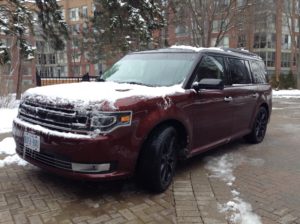
Fortunately, weather didn’t put a damper on anybody’s spirits. The Flex was going to prove an able teammate on that quintessential journey, the weekend hockey tournament.
Three of us flew to Québec City, while the paupers, hardy souls and auto reviewers among us took to the road: the 401 east to the 20, detour south to the 30 to bypass Montréal, then back onto the 20 the rest of the way to the bridge across the St. Lawrence to Québec City. Then we played four games in two days (don’t ask how we did), and took to the road again on Monday. Unlike us, the Flex never asked why. It just did what we needed it to do, letting us get to know it during our time together.
First impressions
When I see the Flex, I can’t help but think certain design engineers indulged their inner Lego fanatics. That doesn’t make the Flex unattractive. It’s just unapologetically boxy, no matter how you look at it, and that creates a distinctive look.
It’s also large, a point that hits home when you have to clear snow off the roof, the windshield, the Bronze Fire hood…
The appearance package on my tester added neat touches like the black 20” machined aluminum wheels and black roof.
The Cargo Versatility Package includes roof rails and a Class III tow package.
as well as all-weather floor mats.
Interior
Step inside the cavernous cabin, turn on the ignition and the seat and steering wheel adjust to your driving position. Kill the ignition, and the seat and wheel both retract, making it easier to get out of the infinitely power-adjustable driver’s seat.
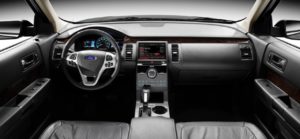
Image courtesy Ford. Image may show a prior year model but details materially resemble the 2016 Ford Flex.
The steering wheel tilts and extends thanks to controls mounted on the steering column that look and work like controls used to adjust side-view mirrors. This control, unlike the Flex’s side-view-mirror control, doesn’t sport a joystick-like protrusion.
That side-mirror control sits on the wide window sill, close to the line of sight where drivers see the left mirror. This switch also lets you fold the mirrors in or out.
Folded in, the lights under the mirror housing mostly illuminate the doors instead of the ground. That downward-pointing light could be made to swivel outwards when the mirrors are tucked in.
The back seat is quite roomy. So roomy, in fact, that when the driver kills the engine and the seat rolls back, the passenger behind the driver experiences no inconvenience. Rear-seat passengers get their own climate controls, seat heaters, charger and cupholders, all of which reside in the rear of the front seat armrest.
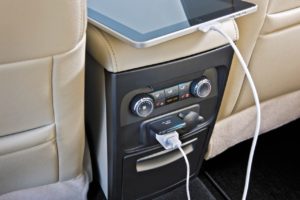
Image courtesy Ford. Image may show a prior year model but details materially resemble the 2016 Ford Flex.
All passengers get to gaze up at the sky through the multi panel vista roof, though only the sunroof above the front seats opens.

Image courtesy Ford. Image may show a prior year model but details materially resemble the 2016 Ford Flex.
Power-folding third-row seats didn’t see any use, though we did play with them a little. (Did I mention this was a boy’s hockey weekend? We had to try the in-car gadgetry.) Four buttons on the inside left wall of the cargo area provide the options needed for bring up both seats or only one. Only the headrests need manual intervention, the tug of a strap on the seat backs.
We learned to be careful when placing hands or gear near the buttons when the cargo area is loaded to the gills. We accidentally triggered the seats a couple of times, then had to unload the cargo area to get the seats to stow themselves. I wonder if Ford engineers could include sensors that could prevent such mishaps. Those sensors would prevent the third-row seats from moving much like a sensor deactivates the front seat passenger airbag when the occupant is too light.
Having those third-row-seat control buttons backlit would make them more useable in low-light conditions, much like the thoughtfully-lit edges of USB ports concealed in the front seat console.
A fifth button above this row sounds a chime and closes the power liftgate two seconds after the button press.
Hockey bag test
I use my hockey bag to illustrate the cargo room of a vehicle. One bag isn’t enough to show just how much stuff the Flex can accommodate.
The Flex swallowed three bags, sticks and weekend baggage with ease. We folded the “-40” second row seat so that we could lay all the gear flat and maintain the driver’s view out the rear window while the back seat occupant could lounge in the “-60” portion.
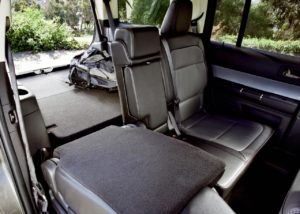
Image courtesy Ford. Image may show a prior year model but details materially resemble the 2016 Ford Flex.
In-car technology
Ford’s optional Sync3 provides a full suite of features, from navigation to entertainment to phone to climate controls to many other settings.
The deeper I dig into Sync3, the more it makes me think of PC Settings on Windows-based computers or System Preferences on Macs. Drivers can customize their on-road experiences in more ways than ever by changing things like the colour of interior accent lighting and the touchscreen’s default colour.
The voice-activated navigation package was a nice touch, but I delegated the programming of arena locations to the teammate riding shotgun. It largely did a great job, though the nav system hadn’t been updated with construction closures. We had to take the same short detour twice, so the third time travelled in that direction, we used a smartphone-based maps application instead for a choice of routes.
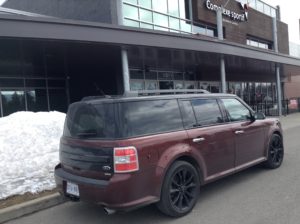
The 2016 Ford Flex visits le complexe sportif de l’Ancienne Lorette.
The Flex’s version of Sync3 offers six icons along the bottom of the screen, while other versions show five. The difference is climate controls. When it’s missing, it’s because the Ford has physical climate control buttons and dials. Ford offers very serviceable physical climate controls on other models, and I prefer those to the touchscreen ones in the Flex. I could more easily have activated the heated seats, heated steering wheel and other controls that saw regular use on the trip.
Several embedded climate “buttons” sit flush on the lower part of the centre stack. I couldn’t use them without looking at them, so I stuck with the touchscreen.
In fact, there are very few physical controls on the centre stack. It makes for a very clean look. The oversized volume dial with its embedded volume and track controls works nicely.
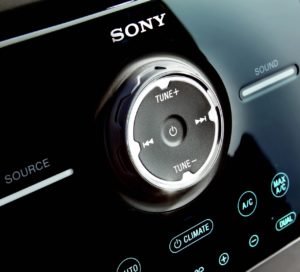
Image courtesy Ford. Image may show a prior year model but details materially resemble the 2016 Ford Flex.
But I couldn’t reliably use the aforementioned climate “buttons” and two other controls without looking at the stack, thereby taking my eyes off the road. I managed to touch the right spots on the touchscreen by bracing the pinky end of my right hand on the shallow ledge under the screen.
I found a USB memory stick full of music in the centre console. I guess I could have used it to push the audio system’s limits. I did this anyway using music on my own playlists, and came away very satisfied with the above-average results.
Given the amount of time we spent on highways, adaptive cruise control got heavily used. It didn’t react as fast as my right foot when inconsiderate drivers cut in close ahead of the Flex, but otherwise it provided for civilized speed and distance settings.
Driving through a sleet storm in eastern Ontario, a message flashed in the instrument cluster noting that adaptive cruise control was unavailable. Cruise is married to adaptive cruise in the Flex, so I couldn’t turn on cruise and control following distance manually.
I handed the manual to one of my teammates, who promptly noted that we likely had ice coating the surface of the vehicle that covers the sensors. At our next gas stop, we simply removed the ice from the bumper and grill by slapping it with our hands, and adaptive cruise worked once more when we got back on the road.
Driving
The optional 3.5-litre V6 EcoBoost provides 365 hp and 350 lb-ft. of torque, all the motivation the Flex needs, thanks to direct injection and turbochargers. The vast majority of our trip passed by in quiet comfort, the engine purring along, but the Flex also handled merging and overtaking on both straight lines and curves. It proved very stable accelerating through 270-degree on-ramps. The steep slopes of Québec City roads leading to our hotel proved no problem to the Ford’s sure-footed AWD system. Ventilated discs on each of the four wheels kept us from rolling too quickly when we drove to the rinks.
The Flex ships with a 6-speed tranny and all the brains required to pick the right gear. I mention the brains because the larger and more utilitarian the vehicle, the more out-of-place paddle shifters seem to be. Yes, there are paddle shifters on the steering wheel of this lengthy vehicle. Why? I don’t see anybody trying Formula One driving starts in the Flex. (Sorry Ford.)
The blind spot information system cross traffic alert is handy, but it’s not difficult to back the Flex into a parking spot, which was what I did just about every time I parked it. The Flex’s turning radius and manoeuvrability in tight spaces was impressive.
The Flex also offers Active Park Assist for parallel parking, but I never thought to use it. I got used to parking this surprisingly nimble behemoth pretty quickly.
Fuel economy
On our trip to Québec, loaded down with three full sets of hockey gear, minimal luggage, coolers (for the rink, of course – what were YOU thinking, dear reader?) and the three players to whom all this gear belonged, we managed just under 11L/100km. On the way back, mileage hovered around 12L/100km.
At early April fuel prices, each fill-up ran almost $60.00 once the Flex informed us it had about 80 km worth of 87-octane juice left in its 70-litre tank.
Pricing
The Limited model is Ford’s top Flex trim. It starts at $43,599 MSRP. My tester, with options, taxes and other charges came to $58,439. The base Flex SE sells for $29,799.